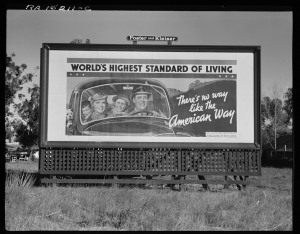The Agency of a Photo
The damage had mostly been done by 1936, when Roy Stryker (of the Farm Security Administration) hired Dorothea Lange, who was doing work photographing the conditions of the Great Depression in cities. She was hired to work for the US, documenting poor rural workers to gain political support in Washington D.C.
While driving through the heart of the affected Dust Bowl area, Lange captured one of the most iconic historical photographs. The story goes as follows:
One dry afternoon, Lange is driving by a pea picker’s camp, where the residents were left with no work due to a recent early-morning frost (many starving) Lange drives for 20 minutes before stopping to turn around and capture the story she shows up at the camp and is drawn in “as if by a magnet,” Lange said, to the Migrant Mother, Florence Owens Thompson, and after 15 minutes, she leaves, having captured one of the most iconic historical photos. But that is not the whole story. Just as with the careful wording of literature and lyrics, though it was done quickly, Lange took four other photos before capturing the masterpiece, manipulating the scene more and more with each photo.

(Lange)
Artists hold a great amount of agency in the remembrance and creation of history. Lange’s photo resulted in the direct aid of the government. She was able to alter the course of history through the power of manipulating public emotion. However, the publication of the photo came its fair share of problems, namely, the breaking of trust and personal invasion required by Lange to share the photo with the public.
The photograph embodied FDR’s famous quote, “The only thing we have to fear is fear itself—nameless, unreasoning, unjustified terror.” The photo showcases the emotion that FDR describes, allowing FDR to remain the strong leader figure without portraying his described emotion himself.
The photo is also a strong weapon against class. The mother’s depicted emotion knows no bounds. Photography can gain sympathy among every class. There are “no social boundaries” when it comes to emotional response (Hariman).
Roosevelt and the New Deal had been hesitant with regard to pro-American capitalism ads of the time. Ads such as the following, taken by Lange in 1937, are a juxtaposition to the raw photo of Thompson.

(Lange)
Based on the photo above, it’s clear that there was a competition within the U.S. to shift the level of idealism even during the disaster. Pro-capitalism ads such as the National Association of Manufacturers’ above perpetuate complacency during a time of a disaster, and thus allow for the continuation of classist exploitation. The more socially accurate depiction in Migrant Mother created with its religious allusion (to the image of Madonna and the Child) would have taken the public’s sacred Christian pathos featured in the image of Madonna and showcased, instead, a deep vulnerability among the innocent.